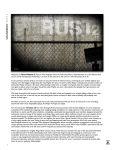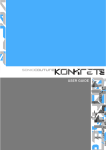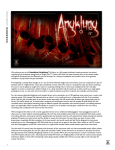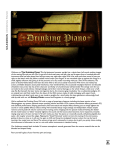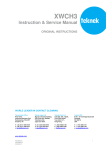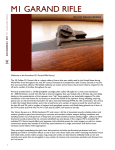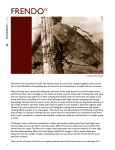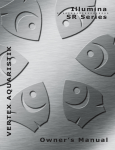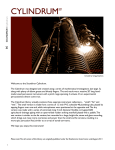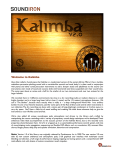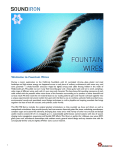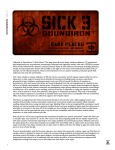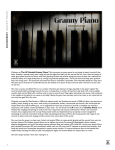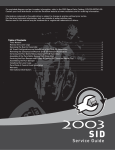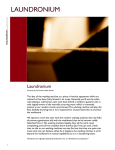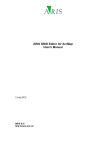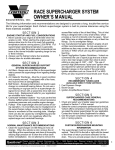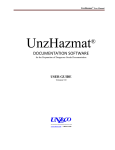Download PDF user manual
Transcript
SOUNDIRON Rust 1 version 2.0 Welcome to Rust Volume 1! This is an eclectic but deep collection of metallic percussion “instruments” recorded in a variety of natural environments. Some objects are roughly tuned to a musical pitch, while others are raw, jagged and purely percussive. This first volume focuses on classic small objects and found sounds, such as metal racks, paint cans, soda cans, magnetic balls, steel pipes, brass hardware, a musical saw and odd bits of furniture, along with large structures like mine shaft gates, steel tunnels, towering stairways and massive structural I-Beams. While a few of the instruments were recorded in one of our favorite large halls or our recording booths, many of these naturally captured sounds were recorded out in the real world, in a lot of uncontrolled and even noisy outdoor or public environments. But hey, when you're trying to capture something strange or new, you can't always micromanage everything around you. You may hear things like stray human voices, bird chirps, distant machinery, road noise, blowing wind or other random sounds hidden in the background of some samples. We consider that subtle coloring as all part of the character, flavor and authenticity unique to these instruments. We feel it's better to have variety than to aim for sterile perfection, in our humble point of view. However, we weren’t simply content to offer up a mightily package of playable sound and call it done. A library this unique demands a complete user interface experience, with endless creative possibilities within easy reach and optimal ram efficiency. For our brand new 2.0 update to Rust 1, we’ve refined key mapping and zone placement, velocity layering, randomization, tuning and more. We’ve also incorporated a full range of user controls to allow total sonic shaping. We’ve also refined sample edits and added a collection of all-new ambient textures and sustaining content. Each preset offers realtime control over every aspect of the sound, allowing you to shape note Attack and sample Offset to create gentle, ghostly pad-like sounds from even the harshest impacts. The Release control let’s you tighten the sound into a sharp staccato click or ping in one moment, or a long ringing sustain the next. Tuning is easy, with the Stepping and main Tune parameters. Our powerful Uberpeggiator allows complex, adaptive arpeggiations and you’ll find tempo-syncing resonant filter and volume LFOs build into nearly every preset. We’ve also included a parametric EQ and convolution reverb with over 50 room and FX impulses to choose from instantly. We’ve also included our mighty Mega Mixer master preset, which lets you choose from any of the percussive elements in the library, load 10 of them dynamically, each with custom key-range, tuning and mapping to create your own ensembles, drum kits and tuned percussion orchestras. The Tuned Selector Ensemble presets give you instant access to sub-categorized collections of solo tuned percussion elements, with easy browsing and automatable instrument selection, while the standard ensemble presets lay it all out for you in convenient untuned drum-kits. Our Trusty Rumbones sustain bank includes 14 custom atmospheric sounds. that can be blended and shaped freely. This library is designed to be easy to use and inspiring to work with, with an incredible depth of sonic potential suitable for use in any musical and sound design genre. 1 SOUNDIRON Rust 1 SOUNDIRON Rust 1 version 2.0 OVERVIEW 24 open-format Kontakt instruments 2,724 Samples 1.74 GB Installed 24bit / 44.1kHz stereo PCM wav samples (non-encrypted) Powerful custom performance and FX control interface Bonus collection of ambiences and atmospheres Bonus: 51 custom convolution reverb impulses Note: • The full version of Kontakt 4.2.4 or later is required for most presets in this library. • The free Kontakt “Player” does not support this library. CREDITS Production, Programming, Recording and Performance by Mike Peaslee and Gregg Stephens UI Design, Artwork & Photography by Constructive Stumblings, Gregg Stephens, Chris Marshall and Mike Peaslee Editing by Mike Peaslee Beta Team: Scripting & Systems Design by Chris Marshall TABLE OF CONTENTS General :: INTRODUCTION - Page 1 OVERVIEW & CREDITS - Page 2 Technical :: FIDELITY, ACOUSTICS, FORMAT & CONVOLUTION - page 3 SYSTEM REQUIREMENTS, DOWNLOAD & INSTALLATION - Page 4 User Interface :: MAIN FRONT PANEL CONTROLS - Page 5 EQ CONTROLS - Page 6 UBERPEGGIATOR CONTROLS - Page 7 LFO & FILTER CONTROLS - Page 8 CONVOLUTION REVERB CONTROLS - Page 9 SUSTAINS & LEGATO CONTROLS - Pages 10 MEGAMIXER CONTROLS - Page 11 MASTER LAYER CONTROLS & PRESET SUB-TYPES - Page 12 Instrument Descriptions :: MASTER PRESETS - Pages 12 ENSEMBLE & AMBIENCE PRESETS - Pages 13 - 14 Info :: LICENSE AGREEMENT - Page 15 THANK YOU - Page 16 www.soundiron.com 2 SOUNDIRON Rust 1 ABOUT THIS LIBRARY Fidelity Custom Convolution Impulses This library was recorded in wide stereo at 44kHz / 24bit, with some content recorded on location in a variety of live environments, so you’ll hear environmental coloration and tone as well as a few background impurities in some samples. We feel these subtle natural imperfections add life and character to the sound. Therefore, please keep in mind that this library isn’t designed to provide perfectly quiet or sterile samples. We enjoy capturing the unique acoustic characteristics of spaces and locations that we come across from time to time. Sampling environments is similar to sampling instruments in many ways. It’s done with portable loudspeakers to produce a special sine wave sweep that covers a wide spectrum, from 22 Hz to 22 kHz. We then use dedicated deconvolution software to decode the resulting audio into an impulse response file, which is a wav file with special phase, frequency and timing information embedded in the audio. Format Accessibility All of the sample content and impulse files are included as standard non-encrypted PCM wav files and standard openformat Kontakt presets to allow you easy access to manipulate, reprogram and customize the sounds however you prefer. We know that it’s important for many users to be able to go beyond the limitations of any one sampler or preset structure, so we’ve kept this library’s directories and files open for advanced users. As a professional, you may have your own workflow or format requirements, and we trust that you'll respect our hard work and won't share this content with anyone who hasn't paid for it. Keep in mind that to use and/or edit the Kontakt presets, you’ll need the full retail version of Native Instruments Kontakt 4.2.4 (K4) or Kontakt 5.0.3 (K5) or later. Please be aware that the free Kontakt “Player” and any other version or form of Kontakt that came bundled with any other library or software product (other than NI’s “Komplete” package) will not support this library. The free Kontakt Player is NOT a full version of Kontakt and cannot load or play standard openformat Kontakt instruments or libraries. Please read all instrument specs and software requirements before purchasing this or any other Soundiron products to see the full list of software requirements, features and format compatibility for each library. Most impulses sound like an odd sort of sharp snap, like a balloon pop or starting pistol fired in the environment that was captured – which is is in fact how impulses used to be made. When loaded into a compatible convolution reverb effect (such as the one built into Kontakt), these impulses impart their sonic properties fairly well into most sounds. Of course, it's an imperfect science and much is lost in the translation, especially if the sound being played through it also has it's own strong tonal, phase or reflective properties. Sometimes the results are incredibly lifelike. Sometimes they're awful. It all depends on the sound, the impulse, the plugin and the settings used. Then again, you may find some unexpectedly useful and interesting results through a little experimentation. We've included a hand-selected collection of impulse files that we think compliment this library’s sound. You can load them into most instrument presets by using the “Convolution” control panel tab and selecting an impulse from the Impulse drop-down menu.You can also manually import any of the wavs in the Impulses directory into any IR wav-compatible convolution effect plugin of your choice. Just please just make sure to keep your speakers or headphones turned down while you experiment. Convolution processing can often create powerful and piercing resonances when applied to many audio sources – especially loud sounds that contain strong mid to low frequency harmonic components. While you can reprogram the samples or presets to other formats, we always recommend using Kontakt for best results, since it widely considered the industry standard and easily the most powerful sample programming and playback platform on the market. However, if you wish to convert or reprogram the wav files and instrument presets into any other sampler or softsynth format, be aware that not all settings and properties will translate accurately, reliably or even at all from one instrument or audio format to the next, due to vast differences in standards, behaviors, structures and capabilities that each platform relies on. 3 SOUNDIRON Rust 1 System Requirements Please be aware that many instrument and multiinstrument programs in this library are extremely ram/ cpu and hard disk-streaming resource intensive. We highly recommend that you have a 64-bit operating system (Windows or OSX) with at least 4GB of system ram, a quad-core cpu and a 7200 rpm SATA hard disk or better before purchasing this particular Soundiron library. Large sample sets like those found in this library may load slowly and may cause system instability on older machines. We provide the Continuata Download Manager to offer high-speed, reliable and fully automated library downloading and installation. Download and run the latest version for your OS (PC or Mac) before proceeding. You may also need to add special permissions to your security software for the downloader, if it blocks applications from accessing the web. Next, copy-paste your download code from your download email into the Code box in the downloader window. Make sure to leave out any spaces before or after the code. Press the download button and select the location you'd like to download and install the library. It will automatically start downloading the file(s) and then error-check, extract and install the finished library. Once installation is fully complete, you can remove the .rar download files and store them in a safe place as a back-up copy. We always recommend downloading the latest version of our downloader before you begin. The link in your email will always take you to the latest version. Don't move, rename, delete or modify any of the files or folders created during the download until after you see the status message for all files in your download queue display the word "INSTALLED". Please don't close the downloader while it's actively downloading, unless you press the pause button first. To resume downloading, press the Resume button. If you need to resume If the downloader reports a DL Error or Install error, it will automatically try to download the file again until it successfully downloads and verifies all the data it needs. It’s best to allow it to finish the process before trying to move or access the library data. Please see your download email for more detailed instructions. Manual Download Download & Installation 4 downloading after closing the downloader, run it again and enter your code and press Download again. Then select the same download/installation location on your computer that you chose originally. If you have any trouble with our Downloader utility or prefer to use your browser or another download manager, log into your personal manual download page on our website, by using the direct link in your download email. Log in using your download code and the email address you used to order. Or, if you used the downloader originally, but you need to re-install the library manually for any reason at a later time you can always re-use the original rar files. To do that, you'll need Winrar, UnrarX or another full-featured Rar extraction utility to extract and install the library. Please note that Stuffit Expander and Winzip DON’T support many types of common rar files. Preset Loading Once installation is complete, you can browse and load the included .nki presets using the Files or Database tabs in the Kontakt Browser, or through the main File load/ save menu. Please allow presets to finish loading completely before loading a new one. You can’t use the Libraries view to load standard open-format Kontakt Instruments like this library. Only locked “Powered-ByKontakt” Libraries are visible to that propriety browser view. The “Add-Library” function does not support this product or any other open-format Kontakt library. This library doesn’t require any special activation. SOUNDIRON Rust 1 Main Front Panel Controls This instrument has a variety of special front panel performance controls that allow deep real-time performance customization. Not all instrument presets include all controls listed below. Included controls depend on the specific features suitable for each preset. Some may also use alternate CC mappings.You can see each control’s assignment by clicking on each UI control to display the “hint” text in the Info bar at the bottom of Kontakt. These controls are included in most presets and control basic sound-shaping parameters. Swell - (CC72) This knob smoothly controls volume swelling for the instrument, allowing you to fine-tune volume, or fast or slow fades over time. Release - (CC93) This controls the release time of the main note samples. Lower settings cause the sound to be damped and cut off, while higher settings allow notes to blend together. Attack - (CC 74) This knob controls the sharpness of attack. Increasing the value causes the sound to attack more softly. Stepping This knob controls the amount of pitch stepping in semitones allowing users to globally tune an instrument up or down by +/- 36 semitones. Offset - (CC91) This controls the amount of sample start offset allowing you to jump ahead into samples to change the sound. Tab Area Button Bar Controls EQ, Uberpeggiator, LFO, Reverb and Global* These buttons change which controls are displayed on the lower right panel of the UI, allowing one to control the various parameters of each effect. See more detailed descriptions of these controls later in this document. *The Global tab is in the Mega Mixer patch only. Uberpeggiator is not included in the Mega Mixer preset 5 SOUNDIRON Rust 1 EQ Controls The EQ tab contains three separate sweepable equalizer bands featuring an adjustable frequency knob for the Mid control. This special panel can be found in all of the instrument presets. Mid Gain This knob sets the amount of gain for the mid band. EQ3 On/Off This button enables/disables the 3-band Parametric EQ. Mid Frq. This sets the center frequency for the sweepable mid band. Low Gain This knob sets the amount of gain for the bass frequency band. 6 High Gain This knob sets the amount of gain for the treble frequency band. SOUNDIRON Rust 1 Uberpeggiator Controls Rust 1 features a flexible, custom arpeggiator system to expand the instant creative potential of some of the presets. It includes automatable performance controls that shape all aspects of the arpeggiator. When used normally, pressing a key causes the note to self-repeat as long as a key is held down. If additional notes are played, it adds them to the sequence of repeats in various ways, depending on the settings you choose and can be used to produce complex melodic chains, plucking patterns and other effects. Mode This knob controls the Arpeggiator mode. Choosing Off disables the Arp system entirely. • On sets it to respond only while a note is pressed., cycling through all held notes as it arpeggiates. • Hold sets it to automatically sustain one note at a time, (monophonic) so that changing keys changes the note that is repeating. • Hold +- sets it to allow new notes to be added to the automated chain of repeats. • EZ Roll is a special ode that allows easy single-stroke roll creation, based on your tempo, rhythm and the amount of swing and randomization you want on the timing and velocity of each stroke. Most other controls are bypassed. You can use the velocity table or use incoming velocities “As Played”. Pitch Sets the pitch up or down in quartertone intervals for each repeat AFTER the initial note is pressed and it remains in a pseudo legato state as long as any key is held down. Changing this setting in real-time allows extreme “glitch” and stair-step effects and can self-generate strange grooves and beats, based on the combination of notes you hold. Free/Constrain Button Limits and adjusts any new note to the currently selected scale and key. Velocity Graph Sequencer This graph allows you to draw the velocities that you want each step in your arpeggiation sequence to play at. Reset This button resets all steps in the graph to a default value of 0 (blank). Swing This sets the amount of rhythmic offset (swing) between notes.Values below zero cause the notes to play ahead of the beat. Values above zero cause the notes to play after the beat. Attenuate This knob attenuates the table velocities by +- 10 velocity steps. Steps This setting determines the number of sequencer steps (2 - 32) that can be set with the velocity graph step sequencer. Duration This knob allows the user to fine-tune the length of each note. Using this, one can shorten the note to staccato-like pulses or extend them beyond the normal beat length. Repeat Setting This sets the direction of the up or down repeats. Rhythm This sets the speed of arpeggiation, as measured in musical time, ranging from whole bars to 128th notes. Fast settings can yield interesting results, but keep in mind that the faster the speed, the more voices you use. Scale Selector Control binds the arpeggiation sequence to a specific scale that you can choose by turning the knob. Note Order Menu This drop-down menu allows you to select any number of simple or complex cycle patterns that the arpeggiation will follow as it plays through the sequence of notes you have triggered. Choosing “As Played” will cause it to follow the original order you played the notes in, with the newest note always added to the end of the chain. Hits and Hit % Knobs Sets the number of repeats of each note BEFORE moving on to the next note in the arp sequence, and Hit % sets the intensity fall-off rate for each repeat, before resetting for the next note. 7 Key Selector Knob Binds the arpeggiation scale you’ve chosen to a specific key. As Played / Table This activates the Graph. When active, the arpeggiation follows the velocities that you’ve drawn on the graph from left to right. When it is bypassed, each note is played at the velocity that it was originally played at. Random This control allows you to add a bit of subtle humanization to velocity and timing for each repeating note in the roll. SOUNDIRON Rust 1 LFO/Filter Tab The LFO tab contains controls for the integrated LFO’s for Volume and Filter. These allow you to create subtle or extreme tremolo and filter sweeping effects. Note that when the Filter LFO is on, the control for Cutoff is disabled and grayed out. Filter On/Off Switch This button enables/disables the Lowpass Filter effect. Rate This controls the speed of the LFO. In free mode, it is smoothly sweepable in real-time and displays the current speed in Hertz (Hz). In Synch Mode, it displays standard time signature divisions, relative to Kontakt's current internal tempo, which can also be controlled by your host sequencer. Please be aware that if an LFO is in Synch Mode, you may hear clicking or popping if you change its time signature Rate value knob while any notes are still currently playing. This is due to functional limitations within Kontakt's internal scripting engine and LFO synching system. If you wish to change the speed of the LFO in real-time while notes are playing, we recommend using “Free” mode. Cutoff This knob sets the filter cut-off frequency. Resonance This knob sets the amount of filter resonance. LFO On/Off Switch This button enables/disables the LFO for the Lowpass Filter effect. Free/Synch Mode Switch This allows you to switch between freely adjustable LFO speed control and tempo-synching mode. If you toggle between these modes in real-time, each mode will remember the last selected value you set for that mode. LFO Shape Menu These drop-down menus are only included in the tuned and effect presets. They allow you to select the waveform shape of the LFO from Sine, Rectangle, Sawtooth and Random. The default shape is a smooth Sine wave. Intensity This controls the depth of the LFO. Turning this know all the way down to the left will turn off the LFO completely. 8 SOUNDIRON Rust 1 Convolution Reverb Controls We’ve incorporated our custom convolution impulses into each instrument preset, with full control over all available convolution effect parameters. Convolution On/Off This button enables/disables the convolution reverb effect. High Pass Sets the high frequency cut-off of the impulse response, allowing you to remove rumble and low end. Custom On/Off Turning this button “On” allows for custom impulse loading. It bypasses the ability to load any of our provided impulses so users can save custom presets with custom impulses. Delay Sets the amount of pre-delay time before the wet signal is returned Dry Sets the amount of dry gain (+/-) that is passed through the effect. Wet Sets the amount of wet gain (+/-) that is passed through the effect. Size Sets the simulated room size of the convolution. Low Pass Sets the low frequency cut-off of the impulse response, allowing you to dull and darken the sound. 9 Impulse menus These menus allow you to select from a wide variety of custom convolution reverb impulses that we've personally captured or created for you, separated into experimental FX impulses and simulated real-world spaces. Effects This menu allows you to select one of our special effect convolutions. Selecting an impulse from this menu overrides and unloads any currently loaded impulse from the Spaces menu. Spaces This menu allows you to select one of our real-world environmental convolutions. Selecting an impulse from this menu overrides and unloads any currently loaded impulse from the Effects menu. SOUNDIRON Rust 1 Sustains Controls Sustains presets contain most of the standard sound-shaping controls as normal presets, but also offer some different functionality. In place of the Uberpeggiator, these patches contain a Legato tab. Layer 1 This dropdown selects the active ambience for the Low layer. It can be automated by attaching CC or host automation to the “Layer 1” label above it. Layer 2 This dropdown selects the active ambience for the High layer. It can be automated by attaching CC or host automation to the “Layer 1” label above it. Blend This knob blends between the Low and High layers, allowing users to morph between any two ambiences. Legato XFade This knob controls the amount of crossfade between samples during legato transitions. Polyphony This knob controls the available number of separate legato positions. Using this allows for up to three separate legato melodies to be played simultaneously. Range This knob controls the interval range within which a legato transition will occur. When used with Polyphony, any legato transition played grater than this setting will trigger another legato position. Speed In Sustains presets, the Speed knob controls the speed of the pseudo-legato pitch bend when it is enabled. When turned all the way down, the bend is slow; turned all the way up, the bend is fast. Bending On/Off This button toggles on/off simulated pitch bending during legato transitions. Legato On/Off This button toggles legato mode on/off. 10 SOUNDIRON Rust 1 Mega-Mixer Ensemble Builder Controls The Rust 1 Mega-Mixer preset provides a special interface that lets you combine 12 different articulations in any key mapping, tuning and arrangement you like. There are 12 loadable articulation modules, each with a window, edit button and vertical slider. Each of these modules has its own independent controls. If you make any changes you’d like to keep, you can save this preset by choosing "Save-As" in the main Kontakt File menu to store your custom settings for later. Make sure to save the new preset with a new file name, in the same "Instruments" folder location, to insure proper loading. Instrument Selection Menu The label of each module is an instrument selection menu and it displays the instrument that is currently loaded into each module. To load an instrument, click on a label of a module and select the instrument from a menu. The sub option for the module selected for editing is displayed on the metal panel in the lower left of the UI. Here you will see the name of the instrument loaded into that module and an articulation selector next to that. Use this menu to switch the instrument's articulation. to set the playable range for the selected module (represented by the red keys), allowing users to place drum articulations wherever they want on the keyboard, even overlapping them. The key-range can also be set using the "Set" buttons. Just click one of the buttons, then press any midi note to set that as the lowest or highest key in the range for the module. The blue keys on the Kontakt keyboard represent the defined key ranges of all other modules, if they extend farther up or down than the module being edited. Instrument Volume Slider The vertical slider next to each window controls the volume level for that module. Tuned When activated, this switch causes the notes for that module to be pitched up and down the semitone scale, with the default pitch centered on the "Root" key. Instrument Articulation Edit Button The edit button allows you to select the specific articulation you want to load for that instrument and then edit all that articulation’s customizable settings. You’ll see those controls in the lower right corner of the interface. Pan The "Pan" knob allows each module to be panned independently. Articulation Selector This drop-down menu let’s you choose the specific articulation to load into a particular module. Each instrument has a unique selection of articulations available. Dynamics The "Dyn." knob adjusts velocity when a note is played for that module, allowing users to adjust the intensity for each module. Key-Mapping Controls Under the Layers section you’ll find the key mapping controls. Notice the buttons next to "Root," "Low" and "High.” The "Root" value sets the root pitch of the layer when the "Tuned" button is active. This value is represented on Kontakt's built-in keyboard by the green key. The "Low" and "High" options are used 11 Microtuning The “M.Tune” knob controls the amount of pitch microtuning, in steps of 1/100th of a semitone.You can globally tune an instrument up or down by +/- 300 cents (3 semitones). SOUNDIRON Rust 1 INSTRUMENT PROGRAMS The instrument presets are divided into three main groups: Master, Ensemble and Ambiences. MASTER The “Master” presets are large combination presets that allow direct access to the complete library and provide a great deal of flexibility and control. Please be aware that they can require a large amount of ram to load, can use much more CPU power and disk streaming resources and will often trigger a large number of voices to play at once. Due to the large number of samples and groups, these presets can often take a longer time to load. Rust 1 All Untuned Ensemble.nki This preset is a simple and easy to use master ensemble preset that features all of the percussive instruments in Rust 1, each mapped over a single key. This preset is mapped from C-1 – E6. Rust 1 All Untuned Ensemble Lite.nki This is a low-memory version of the main untuned ensemble preset, with a reduced number of round robin variations and a shorter sample offset range. It requires roughly half the ram that the full preset uses. Rust 1 Mega Mixer.nki This preset is the master Mega Mixer, which allows you to create custom ensembles, with up to 10 instruments, each with independent tuning and mapping arrangements. Samples are loaded only as needed, so this preset is designed to be very memory efficient. The total key mapping for this preset is freely user defined. (See Page 11) ENSEMBLE TUNED SELECTOR You’ll find a variation on each ensemble preset with the prefix “Tuned Selector.” Tuned Selector patches allow the user to load a single tuned articulation from the full range of sounds included in each ensemble. The selected articulation is tuned and mapped over the entire range of the keyboard.You can also change the articulation in real-time. Once the selection has been changed, the next note you play will use the new articulation, but any previously played note will be allowed to finish playing normally. You can automate the selection by right-clicking (PC) or commandclicking (Mac) on the menu and clicking on the midi assignment pop-up box. Then move any midi controller you wish to assign to the selector menu to confirm the CC assignment. Rust 1 Tuned Ensemble Part 1.nki This is the “Tuned Selector” featuring the first half of all the articulations, from Black Diamond Mine to Monkeyballs, mapped from C-2 - G8. Rust 1 Tuned Ensemble Part 2.nki This is the “Tuned Selector” featuring the first half of all the articulations, from Paintcan to Willow Bridge, mapped from C-2 - G8. 12 SOUNDIRON Rust 1 ENSEMBLE The Ensemble patches are set up as convenient un-tuned drum kit style arrays, with each articulation spanning several keys to allow easy playing with a midi keyboard. We’ve divided them into 18 categories. Black Diamond Mine Airshaft.nki Playing on the steel housing of a huge coal mine air shaft manifold and the bars of an entrance gate. This preset is mapped from A2 – A3. Bottles and Chairs.nki Heavy glass bottles slammed onto a steel bench in a large reverberant hall. This preset is mapped from C3 – C4. Brass Rail.nki A strongly resonant brass track rail for a sliding door, played with fingers. Some articulations include release notes. This preset is mapped from C3 – E5. Coins.nki Loose coins dropping, bouncing, rolling and spinning on hard concrete flooring in an small open hall. Mapped from C1 – C#7. Crowbar.nki A standard crowbar violently striking concrete. This preset is mapped from C2 – G#3. Dolphin Point Bridge.nki A long pedestrian suspension bridge over a coastal marshland waterway. Mapped from C3 – G3. Dumpster.nki A massive steel garbage hauling container, played with hands, boots, sticks, mallets and hammers, from both inside and out. Mapped from C3 – A5. Galvanized Nipples.nki Short galvanized steel plumbing/gas pipes (1/2” and 3/4” x 4 - 9” threaded nipples) being played with a carpenter’s hammer. This preset is mapped from C3 – B3. Metal Racks.nki Heavy steel storage racks and grills being played by hand, stick and mallet. This preset is mapped from C3 – A3. Monkeyballs.nki Magnetic balls bouncing together from varying distances., creating a strange zinging, buzzing effect. This preset is mapped from C3 – F#4. Paintcan.nki An empty steel 1-gallon paint can, played by fingers and hands, using lid tension and palm pressure to shape and bend the note. Some keys have release samples as the pressure is released and the can returns to its normal shape. Mapped from C2 – C#4. 13 SOUNDIRON Rust 1 Saw.nki A classic musical woodcutting saw, played with a violin bow. These are mostly sustaining effects, with an erie quality similar to (and predating) the Theremin. This preset is mapped from C3 – A7. Soda Tabs.nki These are classic aluminum soda cans being taps and plucked in a large hall. Mapped from C3 – A5. Stairwell Rail.nki This is a painted tubular steel stairwell railing structure that went up four stories in a huge open shaft. We recorded various beams and surfaces from the very top down to the bottom floor. Mapped from C2 – C7. STL City Museum.nki These are resonant iron and steel surfaces being played by hand, in the interior of a huge tunnel complex within a very strange and special place in St Louis, MO called the City Museum. Mapped from C3 – E5. Tower Bang.nki These are the heavy steel beams being hammered and kicked in the stairwell tower, recorded from various distances. Mapped from C3– C5. USML Observatory.nki A massive outdoor steel sculpture at the Observatory complex at a university in St Louis.. Mapped from C3 – E5. Willow Bridge.nki A huge iron foot bridge we walked every day once upon a time. Various support structures played by hand, mallet, boot and stick. Mapped from C3 – A6. AMBIENCES Trusty Rumbones.nki This patch features 14 different tonally focused lead and pad sustains.You can use the integrated Low and High layer selectors and Blend control to morph between any two sustains in each category. These presets also include optional polyphonic legato (see Page 10). This preset is mapped from C-2 – G8. 14 SOUNDIRON Rust 1 SOUNDIRON SOFTWARE LICENSING AGREEMENT LICENSE AGREEMENT By installing the product you accept the following product license agreement: RIGHTS Soundiron retains full copyright privileges and complete ownership of all recorded sounds, instrument programming, documentation and musical performances included within this product. All past and future versions of this product, including any versions published or distributed by any other entity are fully bound and covered by this agreement. LICENSE GRANT The license for this product is granted only to a single individual user. No unlicensed use is permitted. All sounds, samples, programming, images, scripting, designs and text contained in this product are copyrights of Soundiron, llc. This software is licensed, but not sold, to you by Soundiron, for commercial and non-commercial use in music, sound-effect creation, audio/video postproduction, performance, broadcast or similar finished content-creation and production use. Individual license holders are permitted to install this library on multiple computers or other equipment only if they are the sole owner and only user of all equipment this software is installed or used on. REFUNDS Downloaded libraries can't be returned, so we can't provide refunds or exchanges. We may choose do so at our own discretion, but please be aware that as soon as you've downloaded it, it can not be returned. RESPONSIBILITY Using this product and any supplied software is at the licensee’s own risk. Soundiron holds no responsibility for any direct or indirect loss arising from any form of use of this product. Soundiron allows you to use any of the sounds and samples in the library(s) you've purchased for the creation and production of commercial recordings, music, sound design, post production, or other content creation without paying any additional license fees or providing source attribution to Soundiron. This license expressly forbids any unauthorized inclusion of any raw or unmixed content contained within this product into any other commercial or non-commercial sample instrument, sound effect library, synthesizer sound bank, or loop or effect library of any kind, without our express prior written consent. TERMS This license agreement is effective from the moment the product is purchased or acquired by any means. The license will remain in full effect until termination by Soundiron, llc. The license is terminated if you break any of the terms or conditions of this agreement, or request a refund for any reason. Upon termination you agree to destroy all copies and contents of the product at your own expense. All past and future versions of this product, including those released through brands other than Soundiron, are covered under the terms of this agreement. This license also forbids any unauthorized transfer, resale or any other form of re-distribution of this product, or its constituent sounds or programming, through any means, including but not limited to re-sampling, reverse engineering, decompiling, remixing, processing, isolating, or embedding into software or hardware of any kind, except where included as part of a multimedia production, rendered musical recording, performance or finished work of sound design of at least 8 seconds or more in length. Licenses cannot be transferred or sold to another entity, without written consent of Soundiron, llc. 15 VIOLATION Soundiron reserves the right to prosecute piracy and defend this copyrighted creation to the fullest extent of civil and criminal law., but we keep our prices fair, our samples and programming accessible whenever possible and avoid cumbersome DRM, registration and activation procedures whenever possible to provide you as much creative freedom and the best user experience possible. If you enjoy our instruments and care about the very hard work that went into this labor of love, then we know you won’t ever pirate or distribute this instrument unlawfully. SOUNDIRON Rust 1 THANK YOU. Thanks for purchasing the Soundiron Rust 1 metallic tuned & untuned percussion library. If you enjoy this creation, we hope you’ll also consider checking out some of our other premium virtual instrument libraries. If you have any questions, troubles, concerns, comments, love-letters or hate mail, feel absolutely free to send it on over to us: [email protected] much obliged, Chris, Gregg and Mike www.soundiron.com [ SOUNDIRON ] 16 All programming, scripting, samples, images and text © Soundiron 2011 - 2012. All Rights Reserved.
















